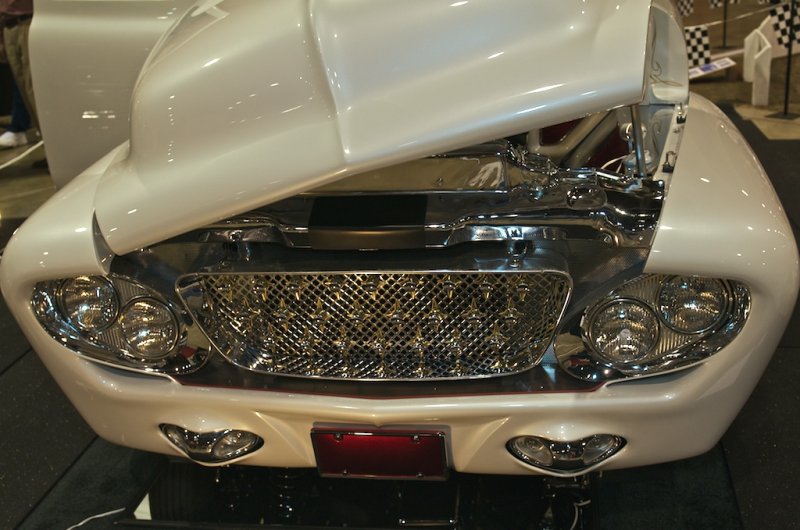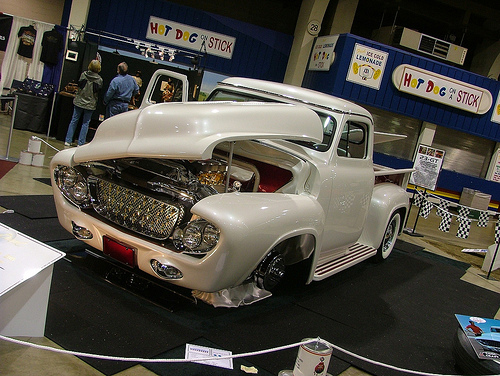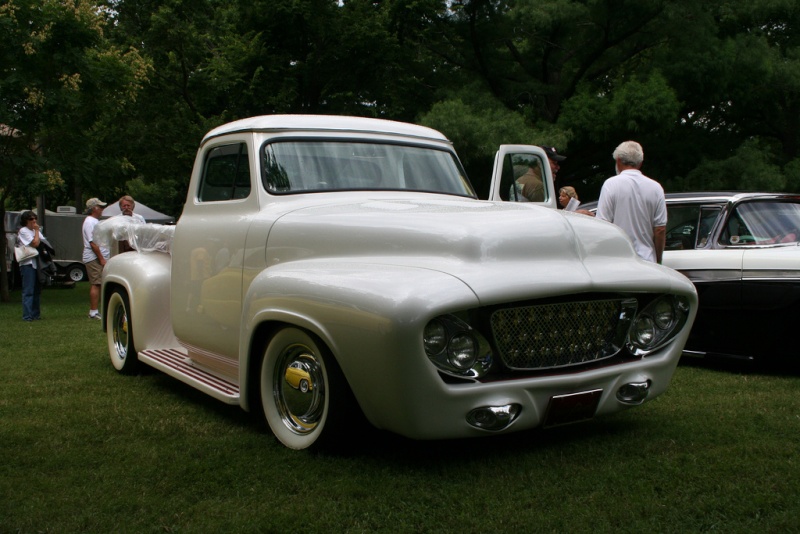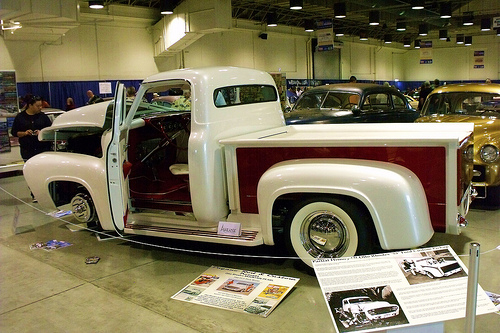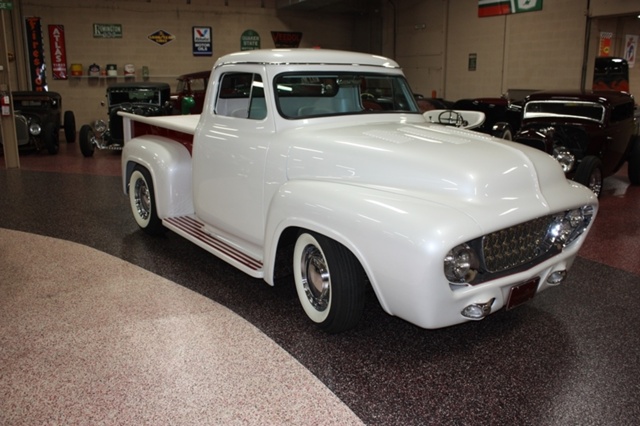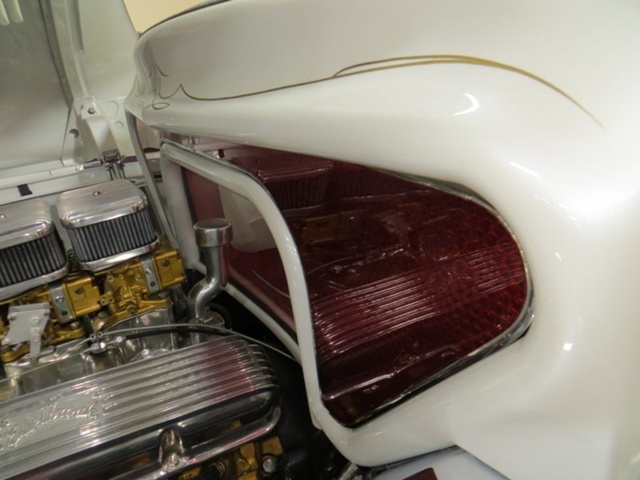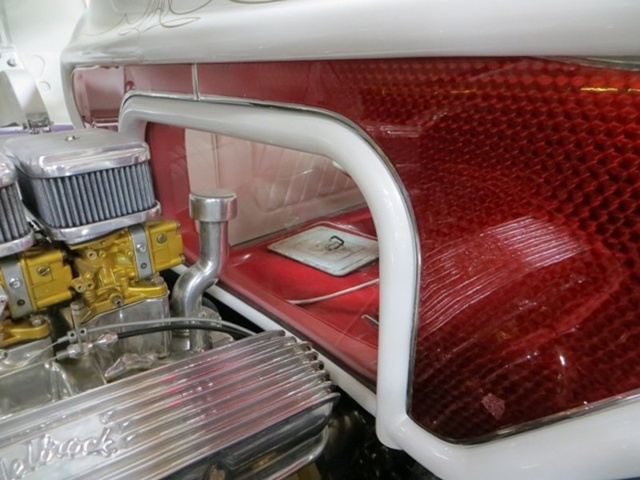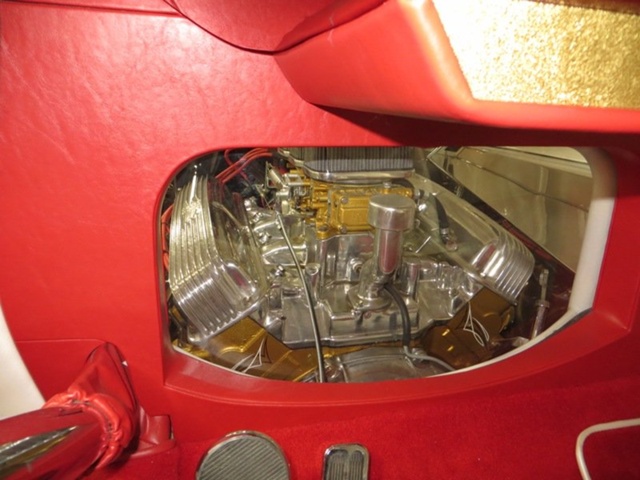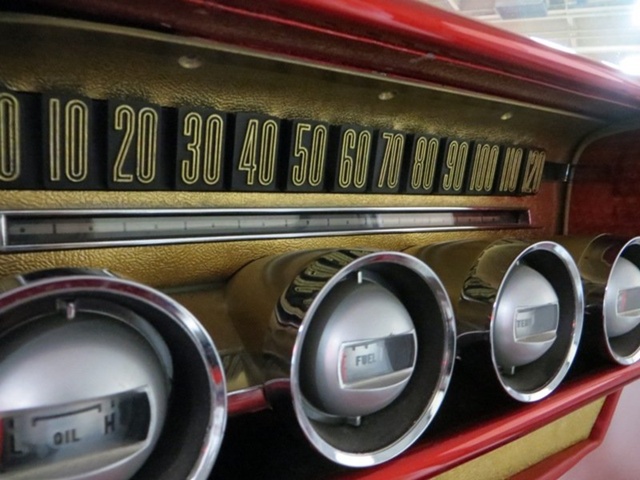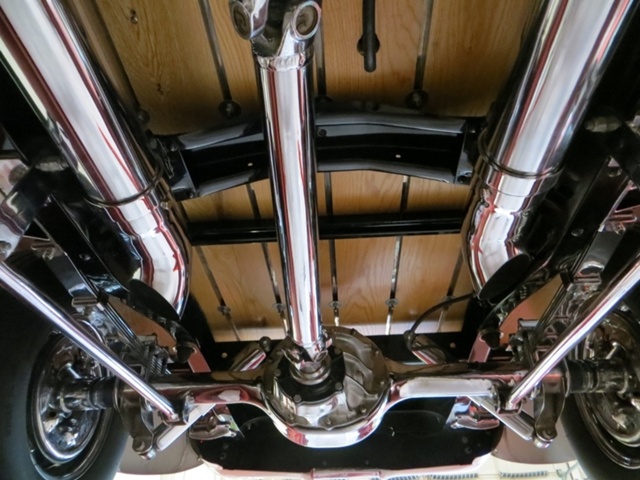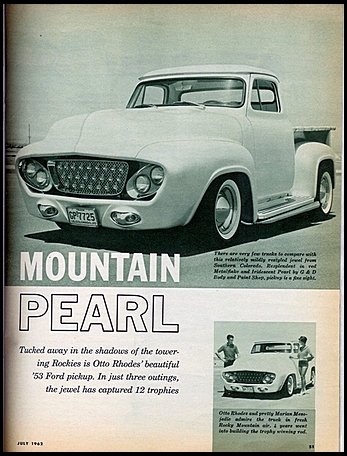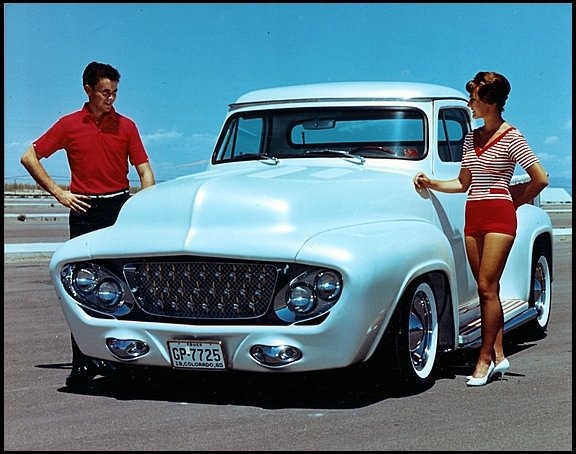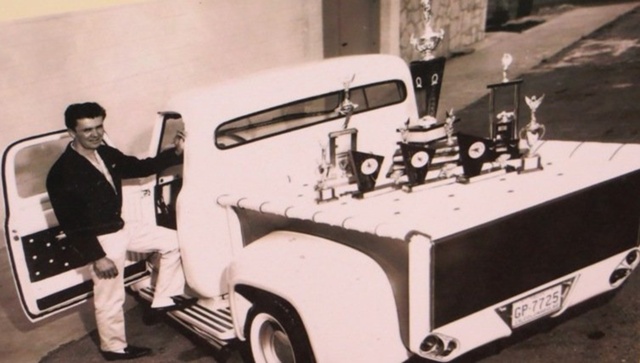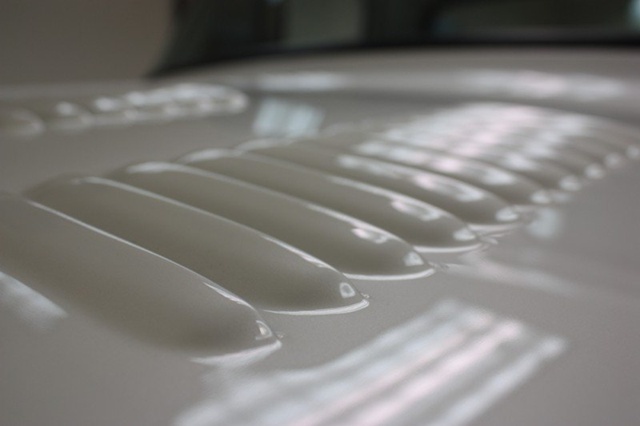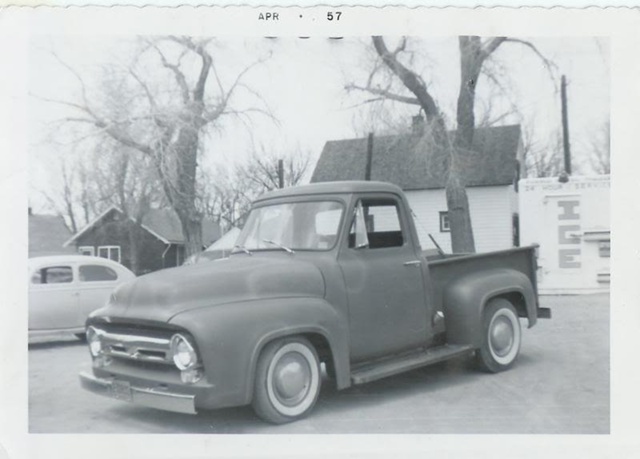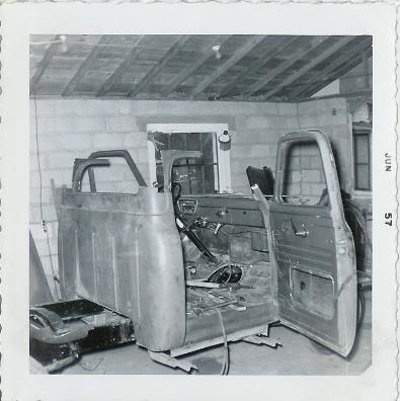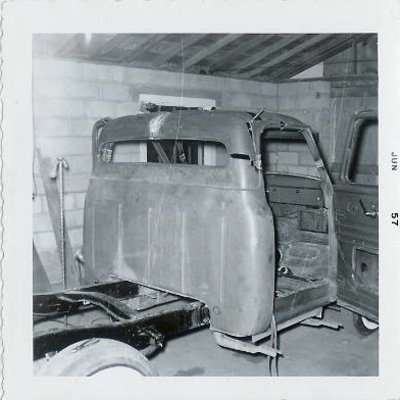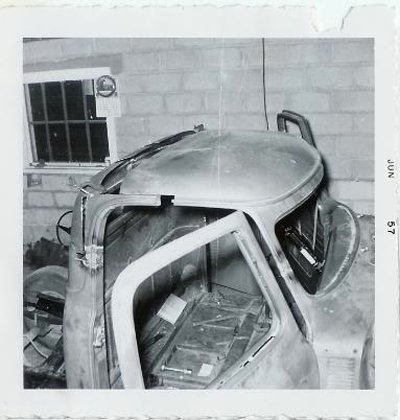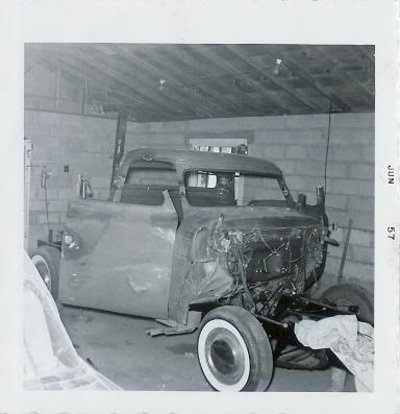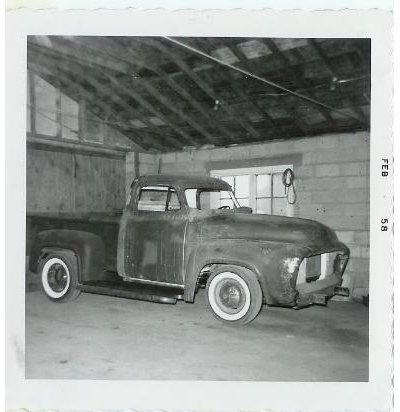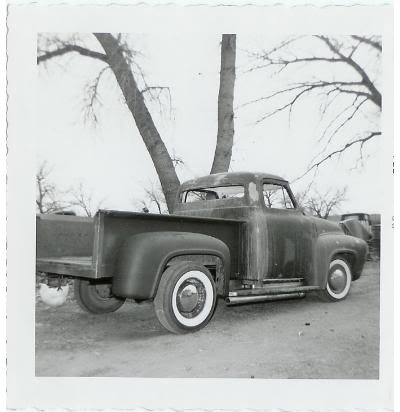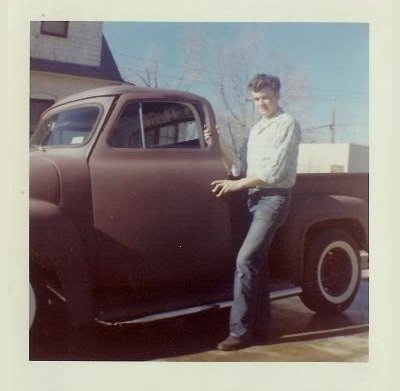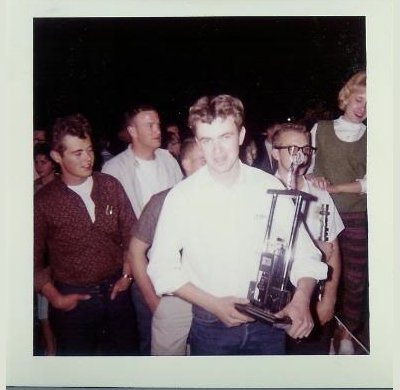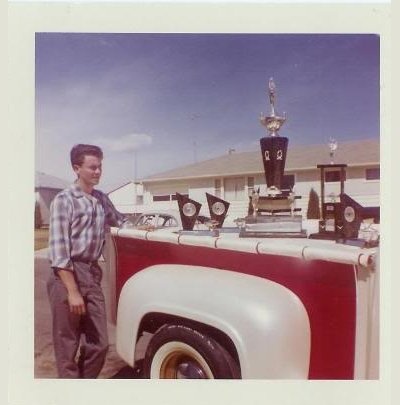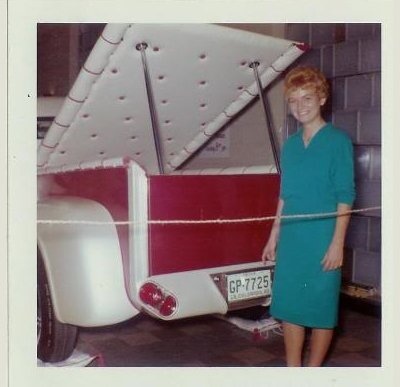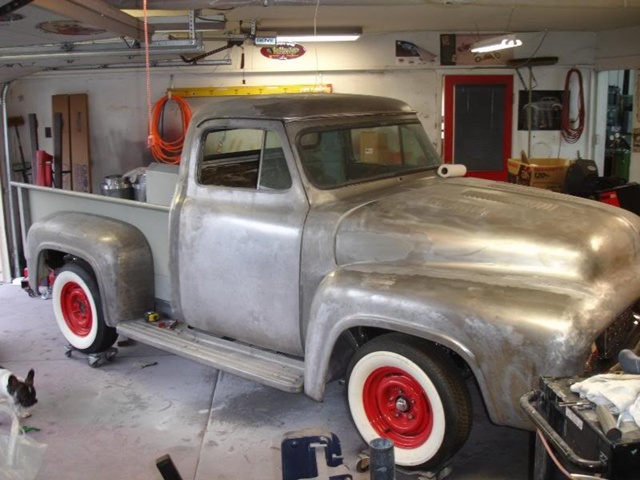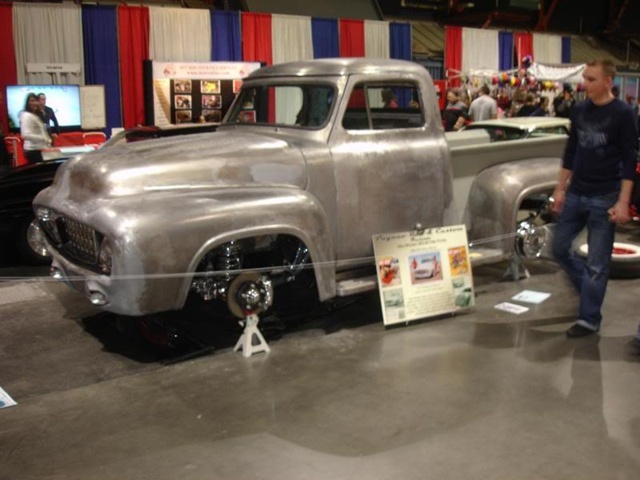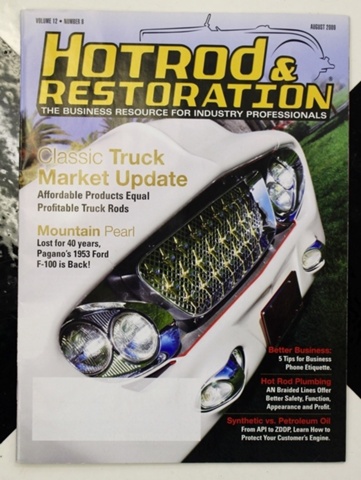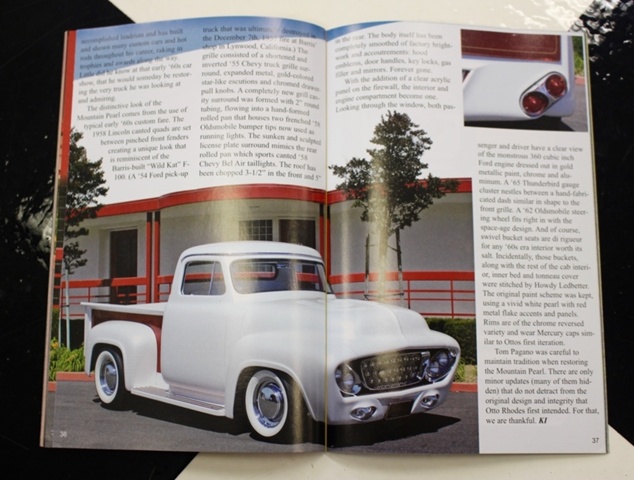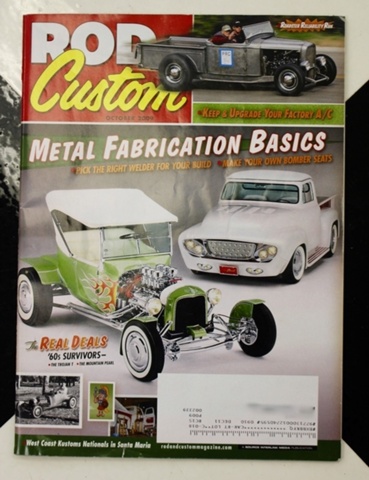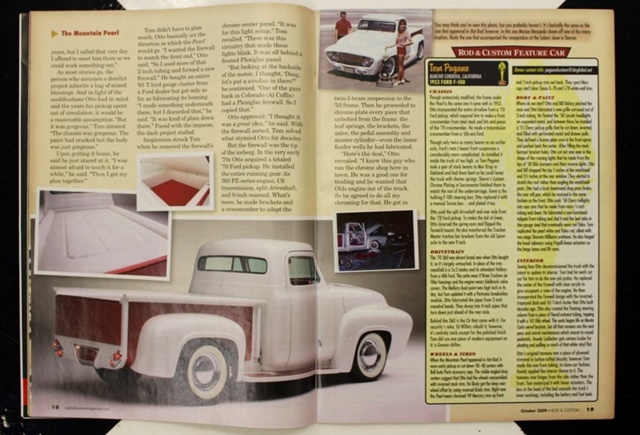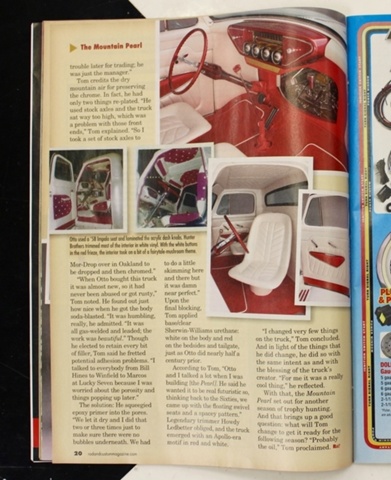1953 Ford F-100 -The Mountain Pearl - Otto Rhodes and Bill Dickey
Traditional Kustom Hot Rod and Vintage Culture and design :: Mild & radical Custom cars database :: Ford
Page 1 sur 1
 1953 Ford F-100 -The Mountain Pearl - Otto Rhodes and Bill Dickey
1953 Ford F-100 -The Mountain Pearl - Otto Rhodes and Bill Dickey

53 Ford F-100 restyled by Otto Rhodes and Bill Dickey of Pueblo, Colorado. The pickup is also known as "The Mountain Pearl" and was restyled by Otto and Bill over a span of four years. In 1962 Otto's truck was the first full-color vehicle featured in Hot Rod Magazine.[4]
Otto bought the truck in September, 1956 after selling his first car, a chopped 1936 Ford Sedan. He had just graduated from high school at the time and began to modify the nearly new truck on a limited student budget. He chromed the front and rear bumper, mounted 1953 Pontiac taillights below the tailgate and dropped the nose over 1950 Mercury wheels. Otto wanted to have the truck painted so he took it to Bill Dickey who owned a body and paint shop with his father-in-law Howard Gentemann. Bill talked Otto into chopping the top. Otto and Bill first chopped the it 5 inches. The result was so ugly that they had to redo it, putting 1.5 inches back in the rear of the cab. Influenced by a Barris Kustoms truck, the project snowballed after the chop. The Barris truck had the front fenders leaned in, and a similar front end treatment to the final result of the Mountain Pearl. Otto and Bill removed the front bumper, and canted the bottom of the fenders in 5 inches towards the truck's centerline. They trimmed the roll pan to match and welded it to the fenders. The license plate cove was created by first defining the shape with 1/4 inch bar stock and tacking it to the roll pan. Otto had never welded prior to starting the restyling of his pickup.[4] Two inch round tubing was used to form a new grille cavity. Canted 1958 Lincoln headlights were fit in the new grille opening along with a flipped and narrowed 1955 Chevrolet pickup grille. Chromed cabinet knobs mounted on perforated steel mesh were placed inside the grille. A combination of parking lights and bumperettes were made from 1958 Oldsmobile back-up lights and set in the front pan. The hood was shaved, peaked,and punched full of louvers. The triangular front end treatment was carried through in the rear and perforated metal was also used behind the license plate. Canted 1958 Chevrolet taillights were used at each end of the rear pan.[5] The rear roll pan was fabricated by a local sheetmetal shop. The bedsides weren't real cherry, so he made light sheet metal pieces and cut holes in them for the fender mounting bolts. The same was done to the tailgate which was bolted in and rendered decorative rather then functional. [4]The inside of the bed was upholstered by Phill Sedita. [5]Bill Dickey and his father-in-law Howard Gentemann of G&D Body and Paint painted the truck in an iridescent pearl-white color. G&D Body and Paint also painted the bedside and tailgate in red Metalflake. The Hunter Brothers Trim Shop upholstered the interior of the truck in white and red frieze and vinyl using a 1958 Chevrolet Impala seat. The truck was fit with cut-down 40-48 Ford wheels sporting Bell Auto accessory caps.[4]
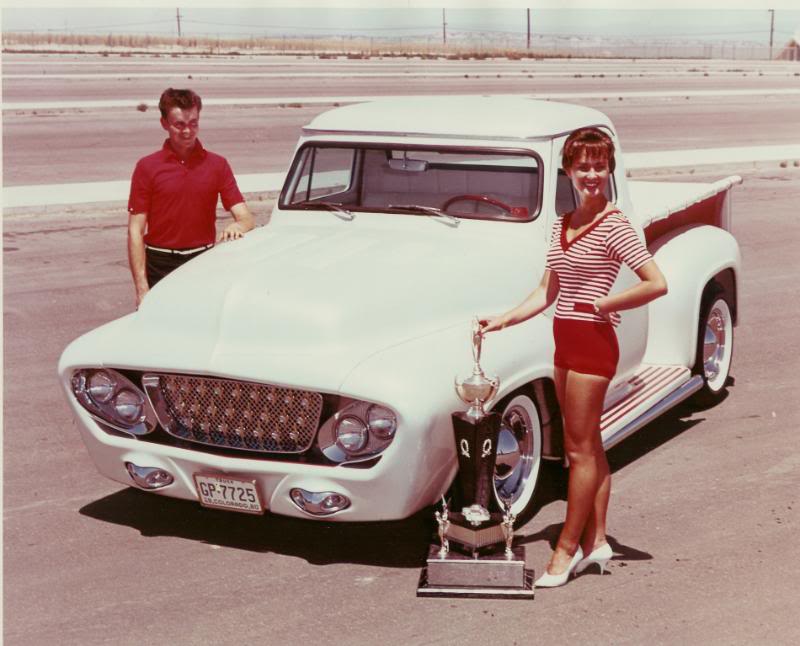
The Mountain Pearl was powered by a bored and stroked 356 cubic inche 1954 Oldsmobile engine that was hopped up with the help of a C-T crankshaft, Thomas mag rockers, Howard F-5 cam, Jahns pistons, Cragar manifold, six Stromberg 97's, Wilcap flywheel and a Cragar adapter.[5] Dan Morgan made the headers using bends from tailpipes and various tubes that and Otto found.[4]
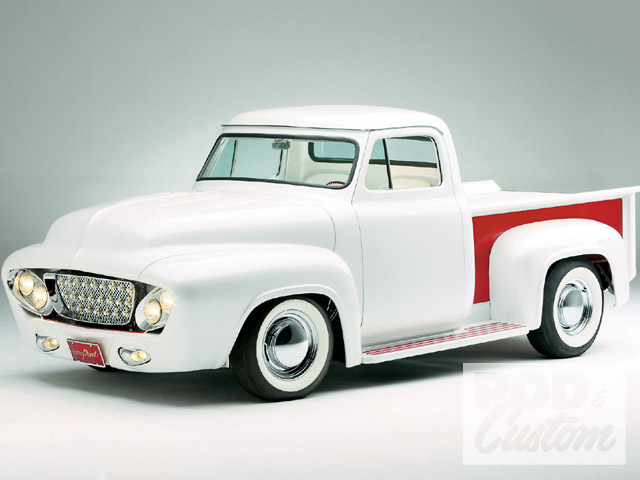
Once completed, the Mountain Pearl made its debut at the Sabers' show at the Denver Coliseum early in 1961. At the show Otto's new pride won 5 awards: sweepstakes for first-place truck, upholstery, paint, and body. Not long after completing the truck Otto was drafted (October 1961) and spent 18 months in Germany. In his absence Bill Dickey displayed the Mountain Pearl at various events. When Otto returned from Germany, Bill talked him into updating the truck and Otto tore it apart; intending to preserve the interior. In 1966 Otto was married and his first child was born in 1967. Needing to take care of the family, he didn't have the funds to use on the project and work progressed slowly until 1973 when it stopped altogether.[4]
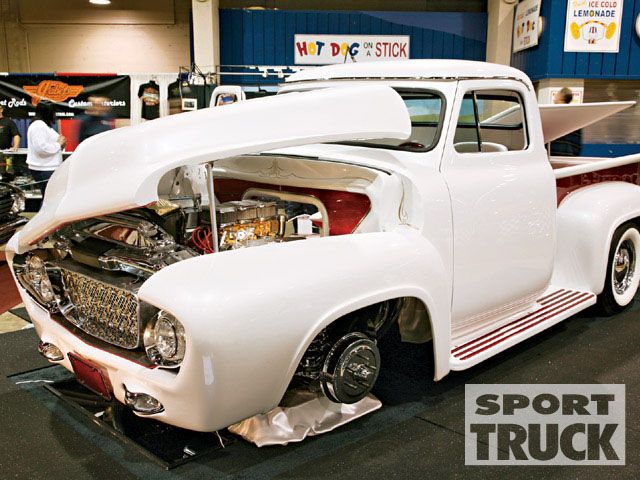
Tom Pagano of Pagano Rod & Custom in Sacramento, who had seen the truck at the first car show he attended when he was 8 years old, bought the Mountain Pearl from Otto Rhodes. The chassis and body were in a good condition when Tom got it. Before Otto had gotten married in 1966 he had started to create a new firewall with a fraome of 2 inch tubing. Otto wanted the new firewall to match the front end. He had also bought a 1965 Ford Thunderbird gauge cluster from a Ford dealer and started to fabricate its housing. When Tom took over the project he wanted to complete what Otto had started. He completed the firewall, but changed it slightly. The new firewall featured a clear acrylic center piece giving occupants a view of the engine; an alternation that Otto liked and approved. Otto had also created a floating steering column from a piece of flared exhaust tubing. The column was topped by a 1962 Oldsmobile steering wheel. In the early 1970s Otto had bought a totaled 1970 Ford pickup and transplanted the entire running gear into the Pearl. He had also chromed every piece that unbolted from the chassis: the leaf springs, the brackets, the axles, the pedal assembly, master cylinder and even the inner fender wells. Jim had swapped the Oldsmobile engine for the chrome job. When Otto restored the truck he only had to rechrome a couple of things.[4]
Tom talked a lot with Otto while rebuilding the Mountain Pearl. Originally Otto wanted the truck to be real futuristic so Tom replaced the Impala seat by floating Monte Carlo swivel seats with an outer space theme. Howdy Ledbetter was responsible for upholstering the second incarnation of the Pearl. Otto's original tonneau was a piece of plywood trimmed in button-tufted biscuits. Tom replaced this with new tonneau framed by tubing. Howdy applied the upholstery for the bed. The new tonneau hinges from the side rather than the front and it was motorized using linear actuators. Chromed 1949 Mercury rims were used up front and 7 inch pickup rims in the rear. Merc caps and Coker Classic G-78 and J-78 white wall tires were chosen for the restored truck.[4] After the restoration, the truck was featured in numerous magazines and won several prizes at shows where it was exhibited.
November 2009 The Mountain Pearl was offered for sale on eBay. The auction ended December 5, 2009 without reaching the reserved price.[3]
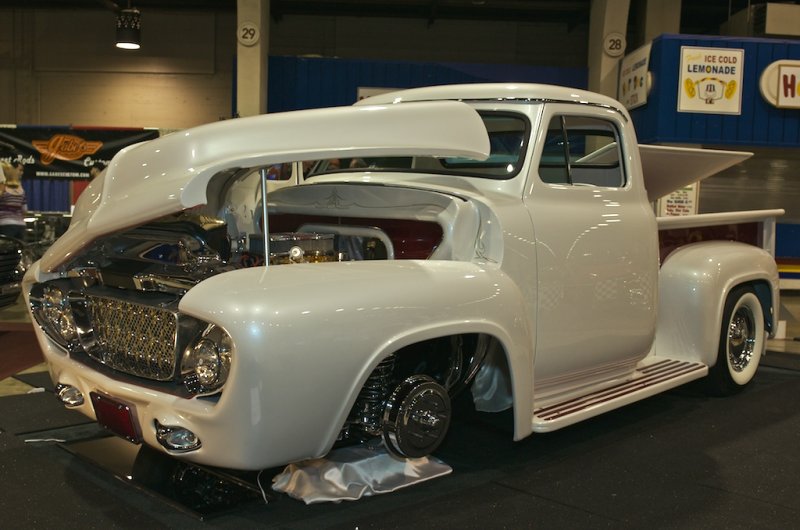
Dernière édition par Predicta le Lun 4 Mai - 20:42, édité 1 fois
_________________
We don't care the People Says , Rock 'n' roll is here to stay - Danny & the Juniors - 1958
 Re: 1953 Ford F-100 -The Mountain Pearl - Otto Rhodes and Bill Dickey
Re: 1953 Ford F-100 -The Mountain Pearl - Otto Rhodes and Bill Dickey
_________________
We don't care the People Says , Rock 'n' roll is here to stay - Danny & the Juniors - 1958
 Re: 1953 Ford F-100 -The Mountain Pearl - Otto Rhodes and Bill Dickey
Re: 1953 Ford F-100 -The Mountain Pearl - Otto Rhodes and Bill Dickey
_________________
We don't care the People Says , Rock 'n' roll is here to stay - Danny & the Juniors - 1958
 Re: 1953 Ford F-100 -The Mountain Pearl - Otto Rhodes and Bill Dickey
Re: 1953 Ford F-100 -The Mountain Pearl - Otto Rhodes and Bill Dickey
_________________
We don't care the People Says , Rock 'n' roll is here to stay - Danny & the Juniors - 1958
 Re: 1953 Ford F-100 -The Mountain Pearl - Otto Rhodes and Bill Dickey
Re: 1953 Ford F-100 -The Mountain Pearl - Otto Rhodes and Bill Dickey
_________________
We don't care the People Says , Rock 'n' roll is here to stay - Danny & the Juniors - 1958
 Re: 1953 Ford F-100 -The Mountain Pearl - Otto Rhodes and Bill Dickey
Re: 1953 Ford F-100 -The Mountain Pearl - Otto Rhodes and Bill Dickey
_________________
We don't care the People Says , Rock 'n' roll is here to stay - Danny & the Juniors - 1958
 Re: 1953 Ford F-100 -The Mountain Pearl - Otto Rhodes and Bill Dickey
Re: 1953 Ford F-100 -The Mountain Pearl - Otto Rhodes and Bill Dickey
_________________
We don't care the People Says , Rock 'n' roll is here to stay - Danny & the Juniors - 1958
 Re: 1953 Ford F-100 -The Mountain Pearl - Otto Rhodes and Bill Dickey
Re: 1953 Ford F-100 -The Mountain Pearl - Otto Rhodes and Bill Dickey
_________________
We don't care the People Says , Rock 'n' roll is here to stay - Danny & the Juniors - 1958
 Re: 1953 Ford F-100 -The Mountain Pearl - Otto Rhodes and Bill Dickey
Re: 1953 Ford F-100 -The Mountain Pearl - Otto Rhodes and Bill Dickey
_________________
We don't care the People Says , Rock 'n' roll is here to stay - Danny & the Juniors - 1958
 Re: 1953 Ford F-100 -The Mountain Pearl - Otto Rhodes and Bill Dickey
Re: 1953 Ford F-100 -The Mountain Pearl - Otto Rhodes and Bill Dickey
_________________
We don't care the People Says , Rock 'n' roll is here to stay - Danny & the Juniors - 1958
 Re: 1953 Ford F-100 -The Mountain Pearl - Otto Rhodes and Bill Dickey
Re: 1953 Ford F-100 -The Mountain Pearl - Otto Rhodes and Bill Dickey
_________________
We don't care the People Says , Rock 'n' roll is here to stay - Danny & the Juniors - 1958
 Re: 1953 Ford F-100 -The Mountain Pearl - Otto Rhodes and Bill Dickey
Re: 1953 Ford F-100 -The Mountain Pearl - Otto Rhodes and Bill Dickey
_________________
We don't care the People Says , Rock 'n' roll is here to stay - Danny & the Juniors - 1958
 Re: 1953 Ford F-100 -The Mountain Pearl - Otto Rhodes and Bill Dickey
Re: 1953 Ford F-100 -The Mountain Pearl - Otto Rhodes and Bill Dickey
_________________
We don't care the People Says , Rock 'n' roll is here to stay - Danny & the Juniors - 1958
 Re: 1953 Ford F-100 -The Mountain Pearl - Otto Rhodes and Bill Dickey
Re: 1953 Ford F-100 -The Mountain Pearl - Otto Rhodes and Bill Dickey
_________________
We don't care the People Says , Rock 'n' roll is here to stay - Danny & the Juniors - 1958
 Re: 1953 Ford F-100 -The Mountain Pearl - Otto Rhodes and Bill Dickey
Re: 1953 Ford F-100 -The Mountain Pearl - Otto Rhodes and Bill Dickey
_________________
We don't care the People Says , Rock 'n' roll is here to stay - Danny & the Juniors - 1958
 Re: 1953 Ford F-100 -The Mountain Pearl - Otto Rhodes and Bill Dickey
Re: 1953 Ford F-100 -The Mountain Pearl - Otto Rhodes and Bill Dickey
_________________
We don't care the People Says , Rock 'n' roll is here to stay - Danny & the Juniors - 1958
 Re: 1953 Ford F-100 -The Mountain Pearl - Otto Rhodes and Bill Dickey
Re: 1953 Ford F-100 -The Mountain Pearl - Otto Rhodes and Bill Dickey
_________________
We don't care the People Says , Rock 'n' roll is here to stay - Danny & the Juniors - 1958
 1953 Ford F-100 – The Mountain Pearl
1953 Ford F-100 – The Mountain Pearl
One Of The Most Significant Custom Pickups Of All Time, Otto Rhodes' Pickup, Fell Off The Map During A Facelift. But It's Back And Prettier Than Ever.
Everybody jokes that a hot rod or custom is never finished, but once upon a time it was gospel. As if by clockwork, trendsetting cars vanished only to reappear the following season even more exuberant.

A thousand miles east and another mile higher than his Southern Californian peers, Otto Rhodes was an unlikely trendsetter. Over a four-year period he sculpted his ordinary F-100 into a chopped, pearl-painted, chrome-laden show stopper that collected gold like a trophy wife with a charge card. The Mountain Pearl certainly set precedent in 1962, the year it became the first full-color vehicle featured in Hot Rod magazine. And just like clockwork it disappeared…only it never returned.
Nor did it disappear for good. Otto’s truck was unique, but so is its story. After bouncing among garages for more than 40 years, the Mountain Pearl is back.
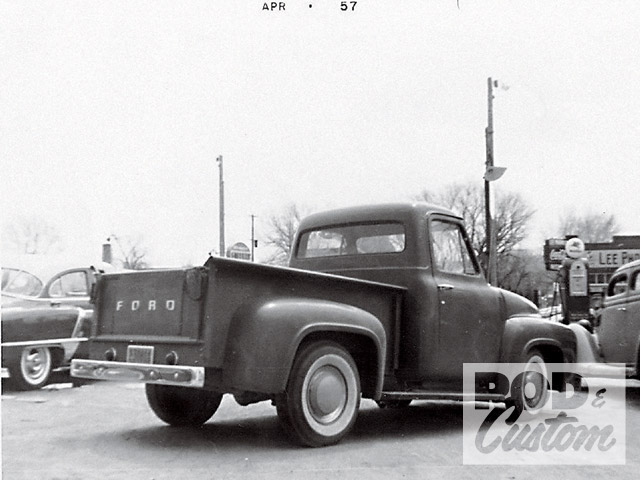
Culturing the Pearl
Otto’s story with the truck began in September, 1956, right after he graduated high school. He’d sold his first car, a chopped ’36 Ford sedan, and acquired what was then a nearly new ’53 F-100. He proceeded to do things within a teenager’s reach: he chromed the bumper, mounted ’53 Pontiac taillights below the tailgate, and dropped the nose over ’50 Merc wheels.
“I wanted to get it painted,” he explained. “This guy I knew had a body and paint shop.” Only Otto got a bit more than he bargained for. “He talked me into chopping the top,” he said. “One thing led to another, you know.”
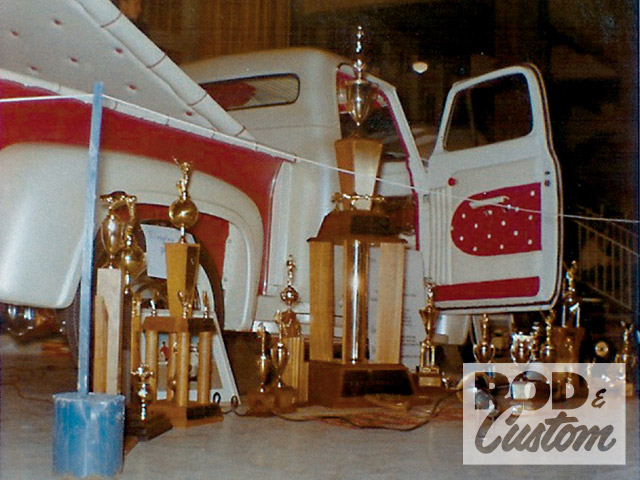
Otto and his friend Bill Dickey chopped the truck-twice in fact. “We first chopped it 5 inches and man was it ugly,” he explained. Effie fashionistas understand why: the side windows on slant-post F-100s taper backwards. “The front of the roof is actually higher, so we put an inch and a half back in the rear.”
From there the project snowballed. “I was kind of influenced by a Barris truck from then,” he said. “It had the front fenders leaned in and that whole theme on the front end.” But rather than copy it, he and Bill improved it.

They began the nose treatment by pulling the leading edges of the fenders 5 inches towards the truck’s centerline. They trimmed the roll pan to match and welded it to the fenders.
The new nose opening started as chunks of 2-inch mandrel bends that Otto pieced together. He welded it to the body wherever it touched the existing surround and filled the yawning gaps between the old opening and the new one with sheet. Bear in mind that until this point, Otto had never welded.
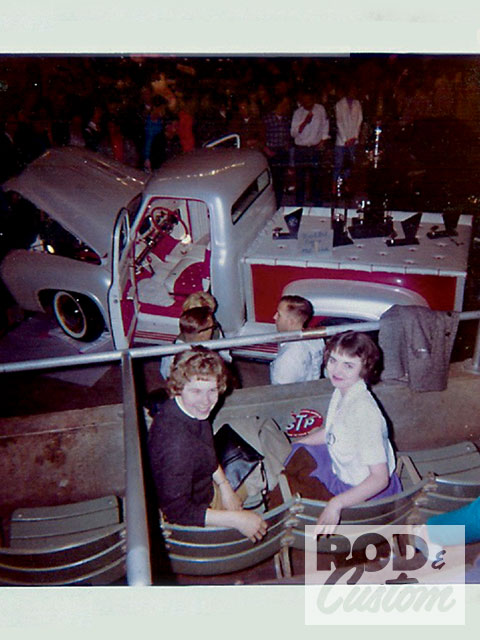
The pair created the license plate cove by first defining the shape with 1/4-inch bar stock and tacking it to the roll pan. Using the rod as a guide, Otto relieved the center. He trimmed a strip from its top, installed it slightly above and back, and filled the gaps.
The front marker lights began life as ’58 Olds rear bumper corners and backup lamps. He cut holes in the apron in their general profile but created the peaked shape with more bar stock. “We were lucky we had Bill Dickey’s father-in-law,” Otto admitted. “He knew how to use lead and to work out those panels by filin’ and beatin’ here and there.”
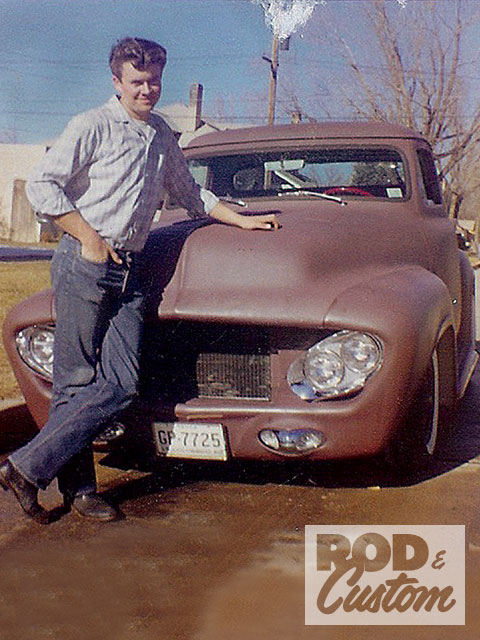
The ’58 Lincoln was about the ugliest car made, but its canted-quad headlights were all the rage when Otto built his truck. Between those is a ’55 Chevy pickup grille that Otto narrowed and flipped. “I put the expanded metal in there and the drawer pulls. To fancy ’em up, you could get these little gold stars to go behind them.”
_________________
We don't care the People Says , Rock 'n' roll is here to stay - Danny & the Juniors - 1958
 Re: 1953 Ford F-100 -The Mountain Pearl - Otto Rhodes and Bill Dickey
Re: 1953 Ford F-100 -The Mountain Pearl - Otto Rhodes and Bill Dickey
A local sheetmetal shop fabricated the rear roll pan and Otto coved it the same way he did in the front. Only instead of finishing it in body color, he skinned the recess with patterned aluminum. Using more 1/4-inch rod he made buckets in the shape of ’58 Bel Air taillight housings. Using them to extend the stake pockets, he canted them like the quads.
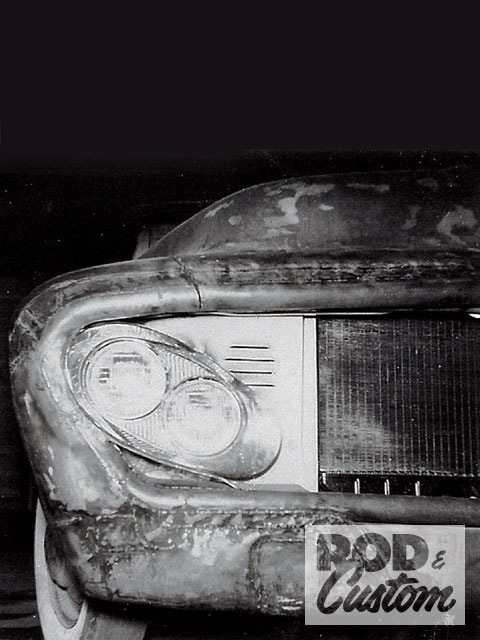
“The bedsides weren’t real cherry,” he noted. “So I got this light sheetmetal and just stuck it up in there and cut the holes for where the fenders bolted on. The same for the tailgate; we fabricated that too. It didn’t open. It just bolted in.”
Otto swapped the Flathead for a ’54 Olds that he bored and stroked to 356ci. “It had a stroker crank, Jahns pistons, Howards cam, and six 97s,” he recalled. “A local racer (Dan Morgan) made the headers using bends from tailpipes and such that we found.”

G&D Body and Paint-the D for Bill Dickey and G for his father-in-law, Howard “Smokey” Gentemann-applied the iridescent pearl-white to the body and red metalflake to the tailgate and bed sides. Hunter Brothers Trim Shop clad the cockpit, which included a ’58 Impala seat, in white and red frieze and vinyl.
“The first show we took the truck to was the Sabers’ show at the Denver Coliseum early in 1961,” Otto said. The pickup, by this time called the Mountain Pearl, won five awards: sweepstakes for first-place truck, upholstery, paint, and body. “I would’ve won the engine, but I used that clear vinyl tubing and it kinked,” he explained. “It was kind of a rush job getting it ready for that show.”
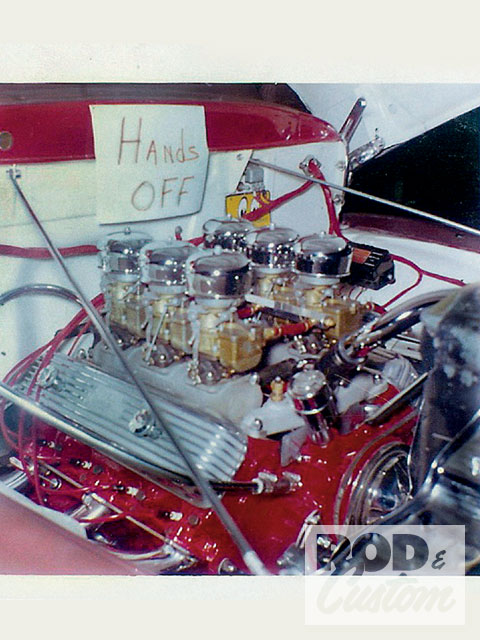
After a couple more shows Tony Spiccola shot the photos that featured the truck in the July ’62 issue of Hot Rod magazine. The Pearl appeared in the following month’s issue as Hot Rod’s very first color photo (a single page shot running vertical with no real explanation)-a curiosity considering the truck was mostly white.
Otto didn’t get very much time with it after finishing it, either. His draft number came up in October 1961. He spent the 18 months after boot camp in Germany and, in his absence, Bill Dickey displayed the Mountain Pearl at various events.
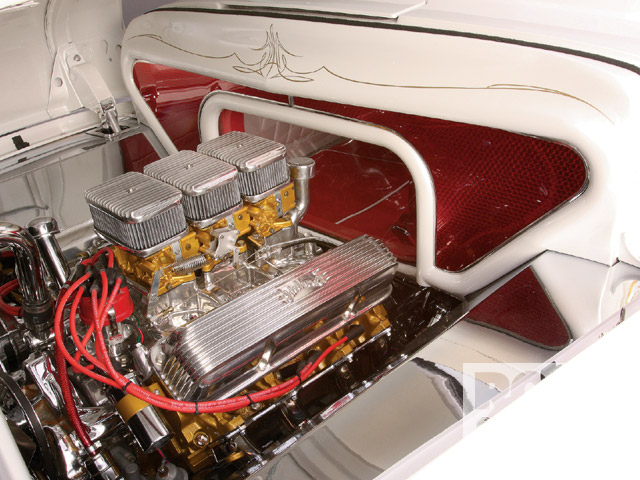
As noted earlier, time is the ultimate show car killer, and three and a half years of limelight may have well turned Otto’s pickup gray. “Bill told me, ‘Well everybody’s seen it; you better update it,'” Otto said with a bemused chuckle. “He talked me into it again.”
Otto tore the truck apart with the intention of preserving its exterior, but it wasn’t in the cards; he’d gotten as far as removing the dash and fabricating a firewall by the time he got married in 1966. In 1967, his son was born. “I couldn’t spend money on it now that I had a family,” he said. Work progressed slowly until 1973, when it stopped altogether. “So basically I stored it for all those years.” The custom car world forgot about Otto Rhodes and his Mountain Pearl.

An Old Gem In A New Setting
“This friend of mine told me if I ever sold the truck, to give him first crack at it,” Otto said. “He thought about it a while, but said he had too many things going so he passed on it.” Only Ray Morlang didn’t just pass on the opportunity; he passed it on to Tom Pagano.
Though he grew up in Pueblo, Tom ended up a world away as far as car culture is concerned: he and his son TJ run Pagano Rod & Custom, a shop on the east edge of Sacramento. To say he remembered the Mountain Pearl is sort of like saying the Pope is Catholic; Otto’s pickup is practically Tom’s reason for being. “That truck was at the very first car show that I went to,” he revealed. “I was eight years old-I didn’t even know that it was a car show, I was so young. It was at the State Fair and I stumbled into this building. And there were all these cars. The next day I started buying models.

“So one day my buddy calls me up and tells me that the truck is for sale,” he continued. “I hadn’t talked to Otto in like 25 years, but I called that very day. I offered to meet him there so we could work something out.”

“The bedsides weren’t real cherry,” he noted. “So I got this light sheetmetal and just stuck it up in there and cut the holes for where the fenders bolted on. The same for the tailgate; we fabricated that too. It didn’t open. It just bolted in.”
Otto swapped the Flathead for a ’54 Olds that he bored and stroked to 356ci. “It had a stroker crank, Jahns pistons, Howards cam, and six 97s,” he recalled. “A local racer (Dan Morgan) made the headers using bends from tailpipes and such that we found.”

G&D Body and Paint-the D for Bill Dickey and G for his father-in-law, Howard “Smokey” Gentemann-applied the iridescent pearl-white to the body and red metalflake to the tailgate and bed sides. Hunter Brothers Trim Shop clad the cockpit, which included a ’58 Impala seat, in white and red frieze and vinyl.
“The first show we took the truck to was the Sabers’ show at the Denver Coliseum early in 1961,” Otto said. The pickup, by this time called the Mountain Pearl, won five awards: sweepstakes for first-place truck, upholstery, paint, and body. “I would’ve won the engine, but I used that clear vinyl tubing and it kinked,” he explained. “It was kind of a rush job getting it ready for that show.”

After a couple more shows Tony Spiccola shot the photos that featured the truck in the July ’62 issue of Hot Rod magazine. The Pearl appeared in the following month’s issue as Hot Rod’s very first color photo (a single page shot running vertical with no real explanation)-a curiosity considering the truck was mostly white.
Otto didn’t get very much time with it after finishing it, either. His draft number came up in October 1961. He spent the 18 months after boot camp in Germany and, in his absence, Bill Dickey displayed the Mountain Pearl at various events.

As noted earlier, time is the ultimate show car killer, and three and a half years of limelight may have well turned Otto’s pickup gray. “Bill told me, ‘Well everybody’s seen it; you better update it,'” Otto said with a bemused chuckle. “He talked me into it again.”
Otto tore the truck apart with the intention of preserving its exterior, but it wasn’t in the cards; he’d gotten as far as removing the dash and fabricating a firewall by the time he got married in 1966. In 1967, his son was born. “I couldn’t spend money on it now that I had a family,” he said. Work progressed slowly until 1973, when it stopped altogether. “So basically I stored it for all those years.” The custom car world forgot about Otto Rhodes and his Mountain Pearl.

An Old Gem In A New Setting
“This friend of mine told me if I ever sold the truck, to give him first crack at it,” Otto said. “He thought about it a while, but said he had too many things going so he passed on it.” Only Ray Morlang didn’t just pass on the opportunity; he passed it on to Tom Pagano.
Though he grew up in Pueblo, Tom ended up a world away as far as car culture is concerned: he and his son TJ run Pagano Rod & Custom, a shop on the east edge of Sacramento. To say he remembered the Mountain Pearl is sort of like saying the Pope is Catholic; Otto’s pickup is practically Tom’s reason for being. “That truck was at the very first car show that I went to,” he revealed. “I was eight years old-I didn’t even know that it was a car show, I was so young. It was at the State Fair and I stumbled into this building. And there were all these cars. The next day I started buying models.

“So one day my buddy calls me up and tells me that the truck is for sale,” he continued. “I hadn’t talked to Otto in like 25 years, but I called that very day. I offered to meet him there so we could work something out.”
_________________
We don't care the People Says , Rock 'n' roll is here to stay - Danny & the Juniors - 1958
 Re: 1953 Ford F-100 -The Mountain Pearl - Otto Rhodes and Bill Dickey
Re: 1953 Ford F-100 -The Mountain Pearl - Otto Rhodes and Bill Dickey
As most stories go, the person who assumes a derelict project inherits a bag of mixed blessings. And in light of the modifications Otto had in mind and the years his pickup spent out of circulation, it would be a reasonable assumption. “But it was gorgeous,” Tom intoned. “The chassis was gorgeous. The paint had cracked but the body was just gorgeous.”
Upon getting it home, he said he just stared at it. “I was almost afraid to touch it for a while,” he said. “Then I got my plan together.”

Tom didn’t have to plan much; Otto basically set the direction in which the Pearl would go. “I wanted the firewall to match the front end,” Otto said, “So I used more of that 2-inch tubing and formed a new firewall.” He bought an entire ’65 T-bird gauge cluster from a Ford dealer but got only as far as fabricating its housing. “I made something underneath there, but I discarded that,” he said. “It was kind of plain down there.” Faced with the impasse, the dash project stalled.
Inspiration struck Tom when he removed the firewall’s chrome center panel. “It was for this light setup,” Tom recalled. “There was this circuitry that made these lights blink. It was all behind a frosted Plexiglas panel.

“But looking at the backside of the motor, I thought, ‘Dang, let’s put a window in there!'” he continued. “One of the guys back in Colorado (Al Coffin) had a Plexiglas firewall. So I copied that.”
Otto approved; “I thought it was a great idea,” he said. With the firewall sorted, Tom solved what stymied Otto for decades.

But the firewall was the tip of the iceberg. In the very early ’70s Otto acquired a totaled ’70 Ford pickup. He installed the entire running gear: its 360 FE-series engine, C6 transmission, split driveshaft, and 9-inch rearend. What’s more, he made brackets and a crossmember to adapt the twin-I-beam suspension to the ’53 frame. Then he proceeded to chrome-plate every piece that unbolted from the frame: the leaf springs, the brackets, the axles, the pedal assembly and master cylinder-even the inner fender wells he had fabricated.
“Here’s the deal,” Otto revealed. “I knew this guy who ran the chrome shop here in town. He was a good one for trading and he wanted that Olds engine out of the truck. So he agreed to do all my chroming for that. He got in trouble later for trading; he was just the manager.”
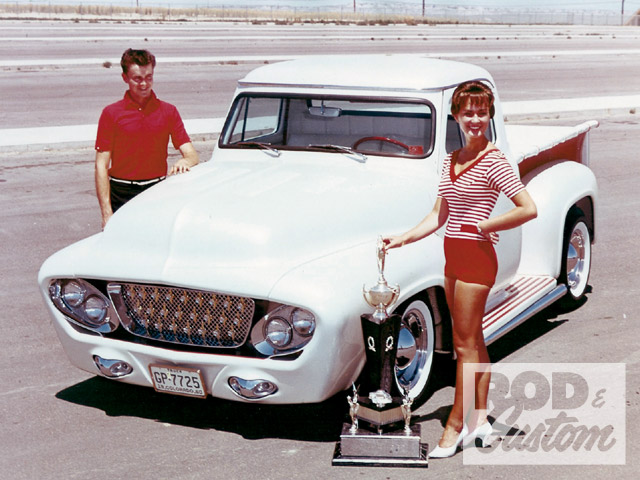
Tom credits the dry mountain air for preserving the chrome. In fact, he had only two things re-plated. “He used stock axles and the truck sat way too high, which was a problem with those front ends,” Tom explained. “So I took a set of stock axles to Mor-Drop over in Oakland to be dropped and then chromed.”
“When Otto bought this truck it was almost new, so it had never been abused or got rusty,” Tom noted. He found out just how nice when he got the body soda-blasted. “It was humbling, really, he admitted. “It was all gas-welded and leaded; the work was beautiful.” Though he elected to retain every bit of filler, Tom said he fretted potential adhesion problems. “I talked to everybody from Bill Hines to Winfield to Marcos at Lucky Seven because I was worried about the porosity and things popping up later.”
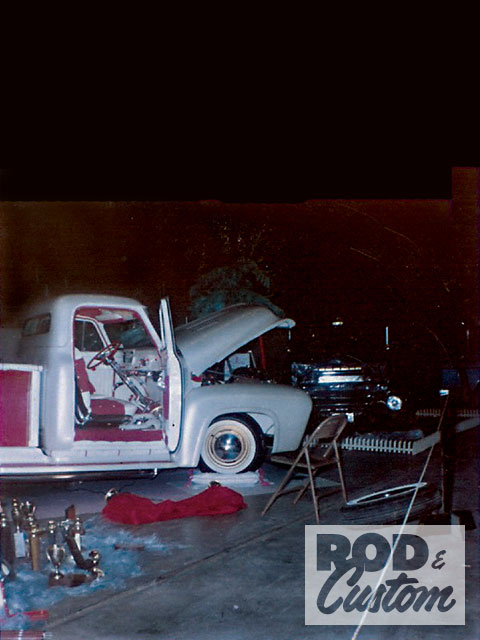
The solution: He squeegied epoxy primer into the pores. “We let it dry and I did that two or three times just to make sure there were no bubbles underneath. We had to do a little skimming here and there but it was damn near perfect.” Upon the final blocking, Tom applied base/clear Sherwin-Williams urethane: white on the body and red on the bedsides and tailgate, just as Otto did nearly half a century prior.
According to Tom, “Otto and I talked a lot when I was building [the Pearl]. He said he wanted it to be real futuristic so, thinking back to the Sixties, we came up with the floating swivel seats and a spacey pattern.” Legendary trimmer Howdy Ledbetter obliged, and the truck emerged with an Apollo-era motif in red and white.
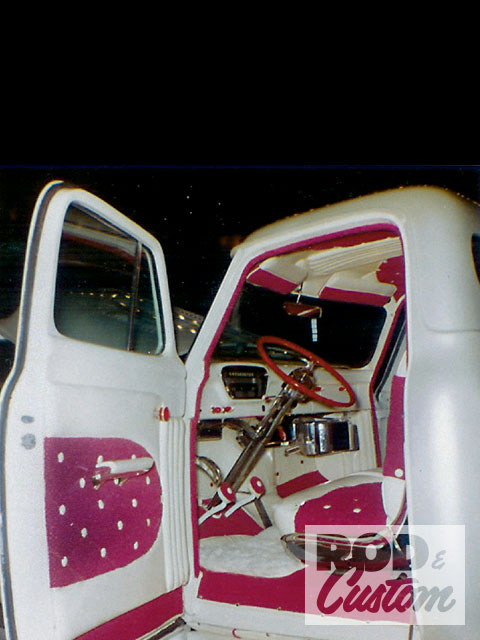
“I changed very few things on the truck,” Tom concluded. And in light of the things that he did change, he did so with the same intent as and with the blessing of the truck’s creator. “For me it was a really cool thing,” he reflected.
Upon getting it home, he said he just stared at it. “I was almost afraid to touch it for a while,” he said. “Then I got my plan together.”

Tom didn’t have to plan much; Otto basically set the direction in which the Pearl would go. “I wanted the firewall to match the front end,” Otto said, “So I used more of that 2-inch tubing and formed a new firewall.” He bought an entire ’65 T-bird gauge cluster from a Ford dealer but got only as far as fabricating its housing. “I made something underneath there, but I discarded that,” he said. “It was kind of plain down there.” Faced with the impasse, the dash project stalled.
Inspiration struck Tom when he removed the firewall’s chrome center panel. “It was for this light setup,” Tom recalled. “There was this circuitry that made these lights blink. It was all behind a frosted Plexiglas panel.

“But looking at the backside of the motor, I thought, ‘Dang, let’s put a window in there!'” he continued. “One of the guys back in Colorado (Al Coffin) had a Plexiglas firewall. So I copied that.”
Otto approved; “I thought it was a great idea,” he said. With the firewall sorted, Tom solved what stymied Otto for decades.

But the firewall was the tip of the iceberg. In the very early ’70s Otto acquired a totaled ’70 Ford pickup. He installed the entire running gear: its 360 FE-series engine, C6 transmission, split driveshaft, and 9-inch rearend. What’s more, he made brackets and a crossmember to adapt the twin-I-beam suspension to the ’53 frame. Then he proceeded to chrome-plate every piece that unbolted from the frame: the leaf springs, the brackets, the axles, the pedal assembly and master cylinder-even the inner fender wells he had fabricated.
“Here’s the deal,” Otto revealed. “I knew this guy who ran the chrome shop here in town. He was a good one for trading and he wanted that Olds engine out of the truck. So he agreed to do all my chroming for that. He got in trouble later for trading; he was just the manager.”

Tom credits the dry mountain air for preserving the chrome. In fact, he had only two things re-plated. “He used stock axles and the truck sat way too high, which was a problem with those front ends,” Tom explained. “So I took a set of stock axles to Mor-Drop over in Oakland to be dropped and then chromed.”
“When Otto bought this truck it was almost new, so it had never been abused or got rusty,” Tom noted. He found out just how nice when he got the body soda-blasted. “It was humbling, really, he admitted. “It was all gas-welded and leaded; the work was beautiful.” Though he elected to retain every bit of filler, Tom said he fretted potential adhesion problems. “I talked to everybody from Bill Hines to Winfield to Marcos at Lucky Seven because I was worried about the porosity and things popping up later.”

The solution: He squeegied epoxy primer into the pores. “We let it dry and I did that two or three times just to make sure there were no bubbles underneath. We had to do a little skimming here and there but it was damn near perfect.” Upon the final blocking, Tom applied base/clear Sherwin-Williams urethane: white on the body and red on the bedsides and tailgate, just as Otto did nearly half a century prior.
According to Tom, “Otto and I talked a lot when I was building [the Pearl]. He said he wanted it to be real futuristic so, thinking back to the Sixties, we came up with the floating swivel seats and a spacey pattern.” Legendary trimmer Howdy Ledbetter obliged, and the truck emerged with an Apollo-era motif in red and white.

“I changed very few things on the truck,” Tom concluded. And in light of the things that he did change, he did so with the same intent as and with the blessing of the truck’s creator. “For me it was a really cool thing,” he reflected.
_________________
We don't care the People Says , Rock 'n' roll is here to stay - Danny & the Juniors - 1958
 Re: 1953 Ford F-100 -The Mountain Pearl - Otto Rhodes and Bill Dickey
Re: 1953 Ford F-100 -The Mountain Pearl - Otto Rhodes and Bill Dickey
With that, the Mountain Pearl set out for another season of trophy hunting. And that brings up a good question: what will Tom change to get it ready for the following season? “Probably the oil,” Tom proclaimed.

Rod & Custom Feature Car
Owner contact info: paganokustom@sbcglobal.net
Tom Pagano
Rancho Cordova, California
1953 Ford F-100
Chassis
Though extensively modified, the frame under the Pearl is the same one it came with in 1953. Otto incorporated the entire driveline from a ’70 Ford pickup, which required him to make a front crossmember from steel stock and bits and pieces of the ’70 crossmember. He made a transmission crossmember from a ’50s-era Ford.
Though only twice as many beams as an earlier axle, Ford’s twin I-beam front suspension is considerably more complicated. As installed it made the truck sit too high, so Tom Pagano took a pair of stock beams to Mor-Drop in Oakland and had them bent so he could lower the truck with shorter springs. Sherm’s Custom Chrome Plating in Sacramento finished them to match the rest of the undercarriage. Gone is the hulking F-100 steering box; Otto replaced it with a manual Torino box…and plated it too.
Otto used the split driveshaft and rear axle from the ’70 Ford pickup. To make the tail sit lower, Otto reversed the spring eyes and flipped the forward mount. He also transferred the Traction Master traction bar brackets from the old Spicer axle to the new 9-inch.
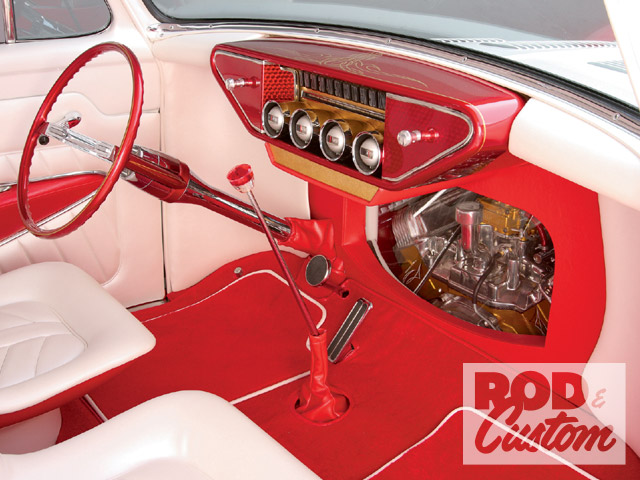
Drivetrain
The ’70 360 was almost brand new when Otto bought it, so it’s largely untouched. In place of the iron manifold is a 3×2 intake and its attendant Holleys from a 406 Ford. The carbs wear O’Brien Truckers air filter housings and the engine wears Edelbrock valve covers. The Mallory dual-point was high tech in its day, but Tom updated it with a Pertronix breakerless module. Otto fabricated the pipes from 2-inch mandrel bends. They dump into 4-inch pipes that turn down just ahead of the rear axle.
Behind the 360 is the C6 that came with it. For security’s sake, Ed Willets rebuilt it; however, it’s entirely stock except for the polished finish. Tom did use one piece of modern equipment on it: a Gennie shifter.
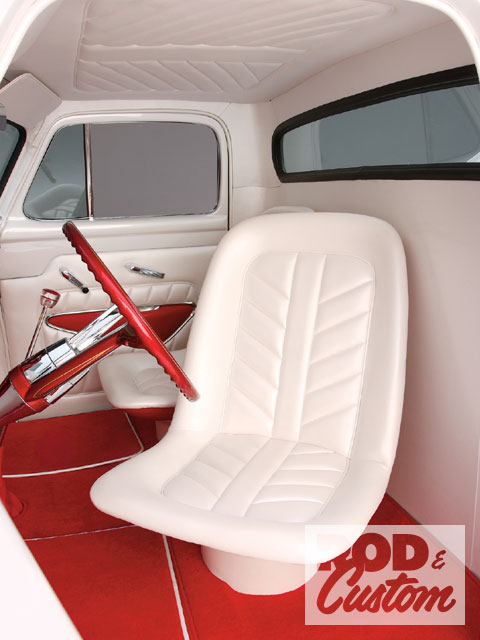
Wheels & Tires
When the Mountain Pearl appeared in Hot Rod, it wore early pickup or cut-down ’40-48 centers with Bell Auto Parts accessory caps. The visible angled drop centers suggest that Otto had the wheels reassembled with reversed stock rims. He likely got the deep rear-wheel offset by using reversed Buick rims. Right now the Pearl wears chromed ’49 Mercury rims up front and 7-inch pickup rims out back. They sport Merc caps and Coker Classic G-78 and J-78 white-wall tires.
Body & Paint
Where do we start? Otto and Bill Dickey pinched the nose and Otto fabricated a new grille surround out of 2-inch tubing. He floated the ’58 Lincoln headlights on expanded metal, and between those he installed a ’55 Chevy pickup grille that he cut down, inverted, and filled with perforated metal and drawer pulls. They defined a license plate cove in the front apron and pushed back the center. After filling the stock bumper bracket holes, Otto cut out new ones in the shape of the running lights that he made from the tips of ’58 Olds bumpers and their reverse lights. Otto and Bill chopped the top 5 inches at the windshield and 31/2 inches at the rear window. They elected to stretch the roof rather than angling the windshield posts. Otto had a local sheetmetal shop press-brake the rear roll pan, which he recessed in the same fashion as the front. Otto sunk ’58 Chevy taillights into rear cans that he made from more 1/4 inch tubing and sheet. He fabricated a non-functional tailgate from tubing and clad it and the bed sides in thin-gauge steel that eventually wore red flake. Tom replicated the pearl white and flake red, albeit with two-stage Sherwin-Williams urethane. He also hinged the hood sideways using Firgelli linear actuators as the hinge bases and lift rams.
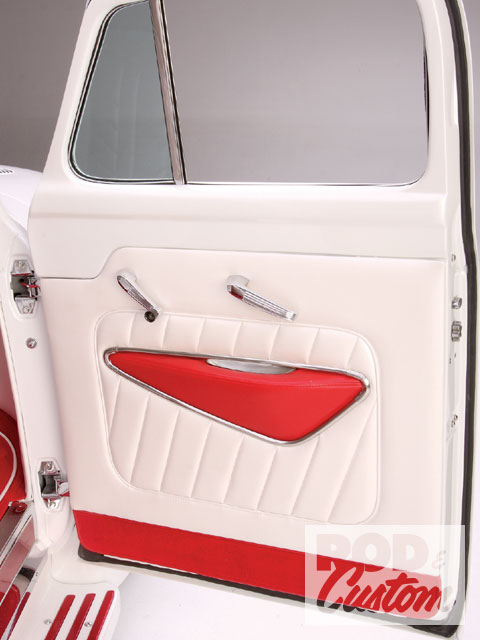
Interior
Seeing how Otto decommissioned the truck with the intent to update its interior, Tom had his work cut out for him to do the new job justice. He replaced the center of the firewall with clear acrylic to give occupants a view of the engine. He then incorporated the firewall design with the inverted-trapezoid dash and ’65 T-bird cluster that Otto built decades ago. Otto also created the floating steering column from a piece of flared exhaust tubing, topping it with a ’62 Olds wheel. The seats began life as Monte Carlo swivel buckets, but all that remains are the seat pans and swivel mechanisms which mount to round pedestals. Howdy Ledbetter gets serious kudos for pleating and pulling so much of that white vinyl flat.
Otto’s original tonneau was a piece of plywood trimmed in button-tufted biscuits; however Tom made this one from tubing. In show-car fashion, Howdy applied the interior theme to it. The tonneau now hinges from the side rather than the front. Tom motorized it with linear actuators. The box at the head of the bed conceals the truck’s inner workings, including the battery and fuel tank.
http://www.hotrod.com/articles/0910rc-1953-ford-f-100/

Rod & Custom Feature Car
Owner contact info: paganokustom@sbcglobal.net
Tom Pagano
Rancho Cordova, California
1953 Ford F-100
Chassis
Though extensively modified, the frame under the Pearl is the same one it came with in 1953. Otto incorporated the entire driveline from a ’70 Ford pickup, which required him to make a front crossmember from steel stock and bits and pieces of the ’70 crossmember. He made a transmission crossmember from a ’50s-era Ford.
Though only twice as many beams as an earlier axle, Ford’s twin I-beam front suspension is considerably more complicated. As installed it made the truck sit too high, so Tom Pagano took a pair of stock beams to Mor-Drop in Oakland and had them bent so he could lower the truck with shorter springs. Sherm’s Custom Chrome Plating in Sacramento finished them to match the rest of the undercarriage. Gone is the hulking F-100 steering box; Otto replaced it with a manual Torino box…and plated it too.
Otto used the split driveshaft and rear axle from the ’70 Ford pickup. To make the tail sit lower, Otto reversed the spring eyes and flipped the forward mount. He also transferred the Traction Master traction bar brackets from the old Spicer axle to the new 9-inch.

Drivetrain
The ’70 360 was almost brand new when Otto bought it, so it’s largely untouched. In place of the iron manifold is a 3×2 intake and its attendant Holleys from a 406 Ford. The carbs wear O’Brien Truckers air filter housings and the engine wears Edelbrock valve covers. The Mallory dual-point was high tech in its day, but Tom updated it with a Pertronix breakerless module. Otto fabricated the pipes from 2-inch mandrel bends. They dump into 4-inch pipes that turn down just ahead of the rear axle.
Behind the 360 is the C6 that came with it. For security’s sake, Ed Willets rebuilt it; however, it’s entirely stock except for the polished finish. Tom did use one piece of modern equipment on it: a Gennie shifter.

Wheels & Tires
When the Mountain Pearl appeared in Hot Rod, it wore early pickup or cut-down ’40-48 centers with Bell Auto Parts accessory caps. The visible angled drop centers suggest that Otto had the wheels reassembled with reversed stock rims. He likely got the deep rear-wheel offset by using reversed Buick rims. Right now the Pearl wears chromed ’49 Mercury rims up front and 7-inch pickup rims out back. They sport Merc caps and Coker Classic G-78 and J-78 white-wall tires.
Body & Paint
Where do we start? Otto and Bill Dickey pinched the nose and Otto fabricated a new grille surround out of 2-inch tubing. He floated the ’58 Lincoln headlights on expanded metal, and between those he installed a ’55 Chevy pickup grille that he cut down, inverted, and filled with perforated metal and drawer pulls. They defined a license plate cove in the front apron and pushed back the center. After filling the stock bumper bracket holes, Otto cut out new ones in the shape of the running lights that he made from the tips of ’58 Olds bumpers and their reverse lights. Otto and Bill chopped the top 5 inches at the windshield and 31/2 inches at the rear window. They elected to stretch the roof rather than angling the windshield posts. Otto had a local sheetmetal shop press-brake the rear roll pan, which he recessed in the same fashion as the front. Otto sunk ’58 Chevy taillights into rear cans that he made from more 1/4 inch tubing and sheet. He fabricated a non-functional tailgate from tubing and clad it and the bed sides in thin-gauge steel that eventually wore red flake. Tom replicated the pearl white and flake red, albeit with two-stage Sherwin-Williams urethane. He also hinged the hood sideways using Firgelli linear actuators as the hinge bases and lift rams.

Interior
Seeing how Otto decommissioned the truck with the intent to update its interior, Tom had his work cut out for him to do the new job justice. He replaced the center of the firewall with clear acrylic to give occupants a view of the engine. He then incorporated the firewall design with the inverted-trapezoid dash and ’65 T-bird cluster that Otto built decades ago. Otto also created the floating steering column from a piece of flared exhaust tubing, topping it with a ’62 Olds wheel. The seats began life as Monte Carlo swivel buckets, but all that remains are the seat pans and swivel mechanisms which mount to round pedestals. Howdy Ledbetter gets serious kudos for pleating and pulling so much of that white vinyl flat.
Otto’s original tonneau was a piece of plywood trimmed in button-tufted biscuits; however Tom made this one from tubing. In show-car fashion, Howdy applied the interior theme to it. The tonneau now hinges from the side rather than the front. Tom motorized it with linear actuators. The box at the head of the bed conceals the truck’s inner workings, including the battery and fuel tank.
http://www.hotrod.com/articles/0910rc-1953-ford-f-100/
_________________
We don't care the People Says , Rock 'n' roll is here to stay - Danny & the Juniors - 1958
 Sujets similaires
Sujets similaires» John Bailey - Otto Rhodes Mountain Pearl Ford F-100, using the Monogram 1/24 kit as the base model
» Legoland kustom city
» 1953 Ford Pick up "F 100" - the Pearl Necklace
» 1957 Ford - White Pearl - John North
» 1951 Ford Pick Up - The Glass Pearl - Jones Rod and Custom
» Legoland kustom city
» 1953 Ford Pick up "F 100" - the Pearl Necklace
» 1957 Ford - White Pearl - John North
» 1951 Ford Pick Up - The Glass Pearl - Jones Rod and Custom
Traditional Kustom Hot Rod and Vintage Culture and design :: Mild & radical Custom cars database :: Ford
Page 1 sur 1
Permission de ce forum:
Vous ne pouvez pas répondre aux sujets dans ce forum
 Connexion
Connexion

